New Half-Metallic Materials: FeRuCrP and FeRhCrP Quaternary Heusler Compounds
Abstract
:1. Introduction
2. Calculation Details
3. Results and Discussion
4. Conclusions
Acknowledgments
Author Contributions
Conflicts of Interest
References
- De Groot, R.A.; Mueller, F.M.; van Engen, P.G.; Buschow, K.H.J. New Class of Materials: Half-metallic Ferromagnets. Phys. Rev. Lett. 1983, 50, 2024. [Google Scholar] [CrossRef]
- Szotek, Z.; Temmerman, W.M.; Svane, A.; Petit, L.; Stocks, G.M.; Winter, H. Half-metallic transition metal oxides. J. Magn. Magn. Mater. 2004, 272, 1816–1817. [Google Scholar] [CrossRef]
- Song, W.; Wang, J.; Wu, Z. Half metallic properties of Sr2CuOsO6. Chem. Phys. Lett. 2009, 482, 246–248. [Google Scholar] [CrossRef]
- Lv, S.; Li, H.; Han, D.; Wu, Z.; Liu, X.; Meng, J. A better ferrimagnetic half-metal LuCu3Mn4O12: Predicted from first-principles investigation. J. Magn. Magn. Mater. 2011, 323, 416–421. [Google Scholar] [CrossRef]
- Zhang, Y.; Liu, W.; Niu, H. Half-metallic ferromagnetism in Cr-doped AlP—Density functional calculations. Solid State Commun. 2008, 145, 590–593. [Google Scholar] [CrossRef]
- Saeed, Y.; Nazir, S.; Shaukat, A.; Reshak, A.H. Ab-initio calculations of Co-based diluted magnetic semiconductors Cd1−xCoxX (X = S, Se, Te). J. Magn. Magn. Mater. 2011, 322, 3214–3222. [Google Scholar] [CrossRef]
- Kobayashi, K.-I.; Kimura, T.; Sawada, H.; Terakura, K.; Tokura, Y. Room-temperature magnetoresistance in an oxide material with an ordered double-perovskite structure. Nature 1998, 395, 677–680. [Google Scholar] [CrossRef]
- Galanakis, I.; Mavropoulos, P. Zinc-blende compounds of transition elements with N, P, As, Sb, S, Se, and Te as half-metallic systems. Phys. Rev. B 2003, 67, 104417. [Google Scholar] [CrossRef]
- Xu, Y.Q.; Liu, B.G.; Pettifor, D.G. Half-metallic ferromagnetism of MnBi in zincblende phase. Physica B 2003, 329, 1117–1118. [Google Scholar] [CrossRef]
- Yao, K.L.; Gao, G.Y.; Liu, Z.L.; Zhu, L. Half-metallic ferromagnetism of zinc-blende CrS and CrP: A first-principles pseudopotential study. Solid State Commun. 2005, 133, 301–304. [Google Scholar] [CrossRef]
- Yao, K.L.; Gao, G.Y.; Liu, Z.L.; Zhu, L.; Li, Y.L. Half-metallic ferromagnetic semiconductors of V- and Cr-doped CdTe studied from first-principles pseudopotential calculations. Physica B 2005, 366, 62–66. [Google Scholar] [CrossRef]
- Ge, X.F.; Zhang, Y.M. First-principles study of half-metallic ferromagnetism in Zn1−xCrxSe. J. Magn. Magn. Mater. 2009, 321, 198–202. [Google Scholar] [CrossRef]
- Chen, X.Q.; Podloucky, R.; Rogl, P. Ab initio prediction of half-metallic properties for the ferromagnetic Heusler alloys Co 2 M Si (M = Ti, V, Cr). J. Appl. Phys. 2006, 100, 113901. [Google Scholar] [CrossRef]
- Özdoğan, K.; Galanakis, I.; Şaşıoğlu, E.; Aktaş, B. Defects-driven appearance of half-metallic ferrimagnetism in Co–Mn-based Heusler alloys. Solid State Commun. 2007, 142, 492–497. [Google Scholar] [CrossRef]
- Kandpal, H.C.; Fecher, G.H.; Felser, C. Calculated electronic and magnetic properties of the half-metallic, transition metal based Heusler compounds. J. Phys. D Appl. Phys. 2007, 40, 1507. [Google Scholar] [CrossRef]
- Liu, G.D.; Dai, X.F.; Lui, H.Y.; Chen, J.L.; Li, Y.X.; Xiao, G.; Wu, G.H. Mn2CoZ (Z = Al, Ga, In, Si, Ge, Sn, Sb) compounds: Structural, electronic, and magnetic properties. Phys. Rev. B 2008, 77, 014424. [Google Scholar] [CrossRef]
- Özdoğan, K.; Galanakis, I. First-principles electronic and magnetic properties of the half-metallic antiferromagnet Cr2MnSb. J. Magn. Magn. Mater. 2009, 321, L34–L36. [Google Scholar] [CrossRef]
- Sharma, V.; Solanki, A.K.; Kashyap, A. Electronic, magnetic and transport properties of Co2TiZ (Z = Si, Ge and Sn): A first-principle study. J. Magn. Magn. Mater. 2010, 322, 2922–2928. [Google Scholar] [CrossRef]
- Kervan, N.; Kervan, S. A first-principle study of half-metallic ferrimagnetism in the Ti2CoGa Heusler compound. J. Magn. Magn. Mater. 2012, 324, 645–648. [Google Scholar] [CrossRef]
- Kervan, S.; Kervan, N. Half-metallic properties in the Fe2TiP full-Heusler compound. Intermetallics 2013, 37, 88–91. [Google Scholar] [CrossRef]
- Gao, G.Y.; Hu, L.; Yao, K.L.; Luo, B.; Liu, N. Large half-metallic gaps in the quaternary Heusler alloys CoFeCrZ (Z = Al, Si, Ga, Ge): A first-principles study. J. Alloys Compd. 2013, 551, 539–543. [Google Scholar] [CrossRef]
- Klaer, P.; Balke, B.; Alijani, V.; Winterlik, J.; Fecher, G.H.; Felser, C.; Elmers, H.J. Element-specific magnetic moments and spin-resolved density of states in CoFeMnZ (Z = Al, Ga; Si, Ge). Phys. Rev. B 2011, 84, 144413. [Google Scholar] [CrossRef]
- Dai, X.; Liu, G.; Fecher, G.H.; Felser, C.; Li, Y.; Liu, H. New quarternary half metallic material CoFeMnSi. J. Appl. Phys. 2009, 105, 07E901. [Google Scholar] [CrossRef]
- Alijani, V.; Ouardi, S.; Fecher, G.H.; Winterlik, J.; Naghavi, S.S.; Kozina, X.; Stryganyuk, G.; Felser, C.; Ikenaga, E.; Yamashita, Y.; et al. Electronic, structural, and magnetic properties of the half-metallic ferromagnetic quaternary Heusler compounds CoFeMnZ (Z = Al, Ga, Si, Ge). Phys. Rev. B 2011, 84, 224416. [Google Scholar] [CrossRef]
- Karimian, N.; Ahmadian, F. Electronic structure and half-metallicity of new quaternary Heusler alloys NiFeTiZ (Z = Si, P, Ge, and As). Solid State Commun. 2015, 223, 60–66. [Google Scholar] [CrossRef]
- Gökoğlu, G. Ab initio electronic structure of NiCoCrGa half-metallic quaternary Heusler compound. Solid State Sci. 2012, 14, 1273–1276. [Google Scholar] [CrossRef]
- Xiong, L.; Yi, L.; Gao, G.Y. Search for half-metallic magnets with large half-metallic gaps in the quaternary Heusler alloys CoFeTiZ and CoFeVZ (Z = Al, Ga, Si, Ge, As, Sb). J. Magn. Magn. Mater. 2014, 360, 98–103. [Google Scholar] [CrossRef]
- Benkaboul, M.; Rached, H.; Abdellaoui1, A.; Rached, D.; Khenata, R.; Elahmar, M.H.; Abidri, B.; Benkhettou, N.; Bin-Omran, S. Electronic structure and magnetic properties of quaternary Heusler alloys CoRhMnZ (Z = Al, Ga, Ge and Si) via first-principle calculations. J. Alloys Compd. 2015, 647, 276–286. [Google Scholar] [CrossRef]
- Bahramian, S.; Ahmadian, F. Half-metallicity and magnetism of quaternary Heusler compounds CoRuTiZ (Z = Si, Ge, and Sn). J. Magn. Magn. Mater. 2017, 424, 122–129. [Google Scholar] [CrossRef]
- Yan, P.; Zhang, J.; Xu, K. The structural, electronic and magnetic properties of quaternary Heusler alloy TiZrCoIn. Solid State Commun. 2016, 231, 64–67. [Google Scholar] [CrossRef]
- Wang, X.; Cheng, Z.; Wang, J.; Wang, L.; Yu, Z.; Fang, C.; Yang, J.; Liu, G. Origin of the half-metallic band-gap in newly designed quaternary Heusler compounds ZrVTiZ (Z = Al, Ga). RSC Adv. 2016, 6, 57041–57047. [Google Scholar] [CrossRef]
- Berri, S.; Ibrir, M.; Maouche, D.; Attallah, M. Robust half-metallic ferromagnet of quaternary Heusler compounds ZrCoTiZ (Z = Si, Ge, Ga and Al). Comput. Condens. Matter 2014, 1, 26–31. [Google Scholar] [CrossRef]
- Xie, H.H.; Gao, Q.; Li, L.; Lei, G.; Mao, G.Y.; Hu, X.R.; Deng, J.B. First-principles study of four quaternary Heusler alloys ZrMnVZ and ZrCoFeZ (Z = Si, Ge). Comput. Mater. Sci. 2015, 103, 52–55. [Google Scholar] [CrossRef]
- Li, Y.; Liu, G.D.; Wang, X.T.; Liu, E.K.; Xi, X.K.; Wang, W.H.; Wu, G.H.; Dai, X.F. Half-metallicity of the bulk and (001) surface ofNbFeCrAl and NbFeVGe Heusler compounds: Afirst-principles prediction. RSC Adv. 2017, 7, 31707. [Google Scholar] [CrossRef]
- Luo, H.Z.; Zhu, Z.Y.; Ma, L.; Xu, S.F.; Liu, H.Y.; Qin, J.P.; Li, Y.X.; Wu, G.H. Electronic structure and magnetic properties of Fe2YSi (Y = Cr, Mn, Fe, Co, Ni) Heusler alloys: A theoretical and experimental study. J. Phys. D Appl. Phys. 2007, 40, 7121–7127. [Google Scholar] [CrossRef]
- Chen, B.S.; Li, Y.Z.; Guan, X.Y.; Wang, C.; Wang, C.X.; Gao, Z.Y. First-Principles Study of Half-Metallic and Magnetic Properties for the Heusler Alloys Fe2CrX (X = P, As, Sb, Bi). J. Supercond. Nov. Magn. 2015, 28, 1559–1564. [Google Scholar] [CrossRef]
- Clark, S.J. First principles methods using CASTEP. Z. Krist. Cryst. Mater. 2005, 220, 567–570. [Google Scholar] [CrossRef] [Green Version]
- Payne, M.C.; Teter, M.P.; Allan, D.C.; Arias, T.A.; Joannopoulos, J.D. Iterative minimization techniques for ab initio total-energy calculations: Molecular dynamics and conjugate gradients. Rev. Mod. Phys. 1992, 64, 1045. [Google Scholar] [CrossRef]
- Segall, M.D.; Lindan, P.J.D.; Probert, M.J.; Pickard, C.J.; Hasnip, P.J.; Clark, S.J.; Payne, M.C. First-principles simulation: Ideas, illustrations andthe CASTEP code. J. Phys. Condens. Matter 2002, 14, 2717. [Google Scholar] [CrossRef]
- Perdew, J.P.; Burke, K.; Ernzerhof, M. Generalized Gradient Approximation Made Simple. Phys. Rev. Lett. 1996, 77, 3865. [Google Scholar] [CrossRef] [PubMed]
- Maximoff, S.N.; Ernzerhof, M.; Scuseria, G.E. Current-dependent extension of the Perdew–Burke–Ernzerhof exchange-correlation functional. J. Chem. Phys. 2004, 120, 2105–2109. [Google Scholar] [CrossRef] [PubMed]
- Haas, P.; Tran, F.; Blaha, P.; Schwarz, K. Construction of an optimal GGA functional for molecules and solids. Phys. Rev. B 2011, 83, 205117. [Google Scholar] [CrossRef]
- Galanakis, I.; Dederichs, P.H.; Papanikolaou, N. Slater-Pauling behavior and origin of the half-metallicity of the full-Heusler alloys. Phys. Rev. B 2002, 66, 174429. [Google Scholar] [CrossRef]

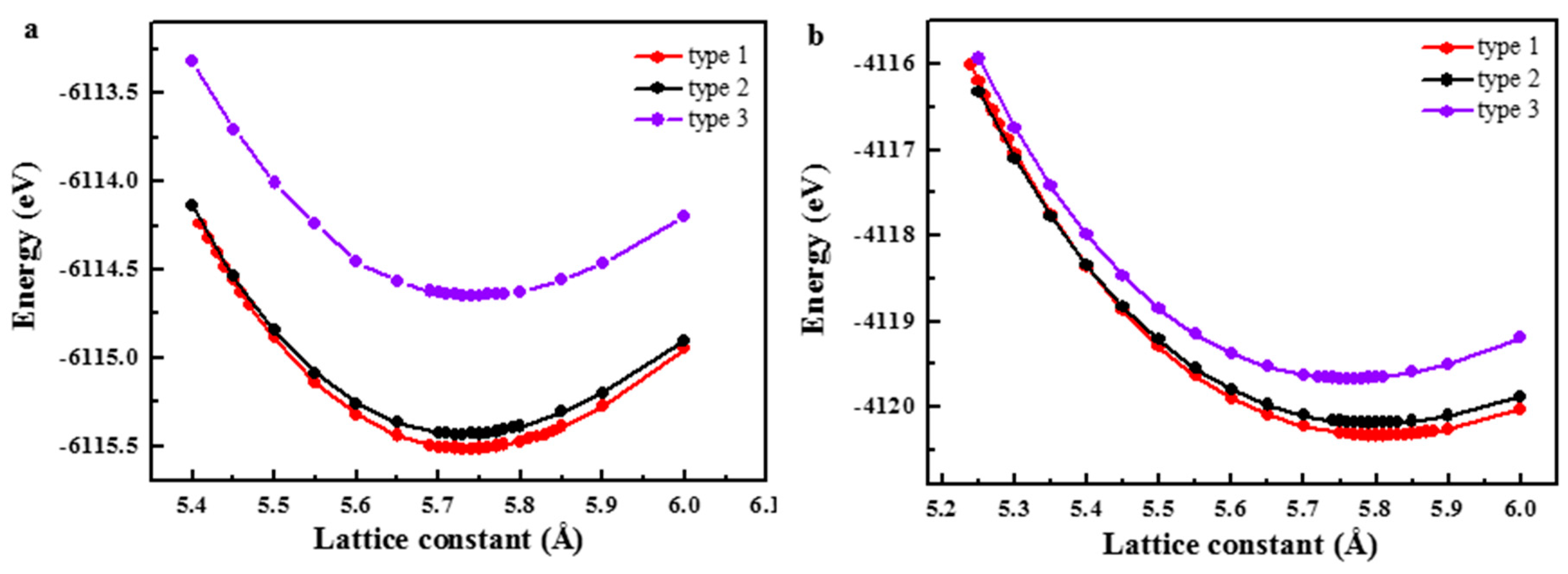
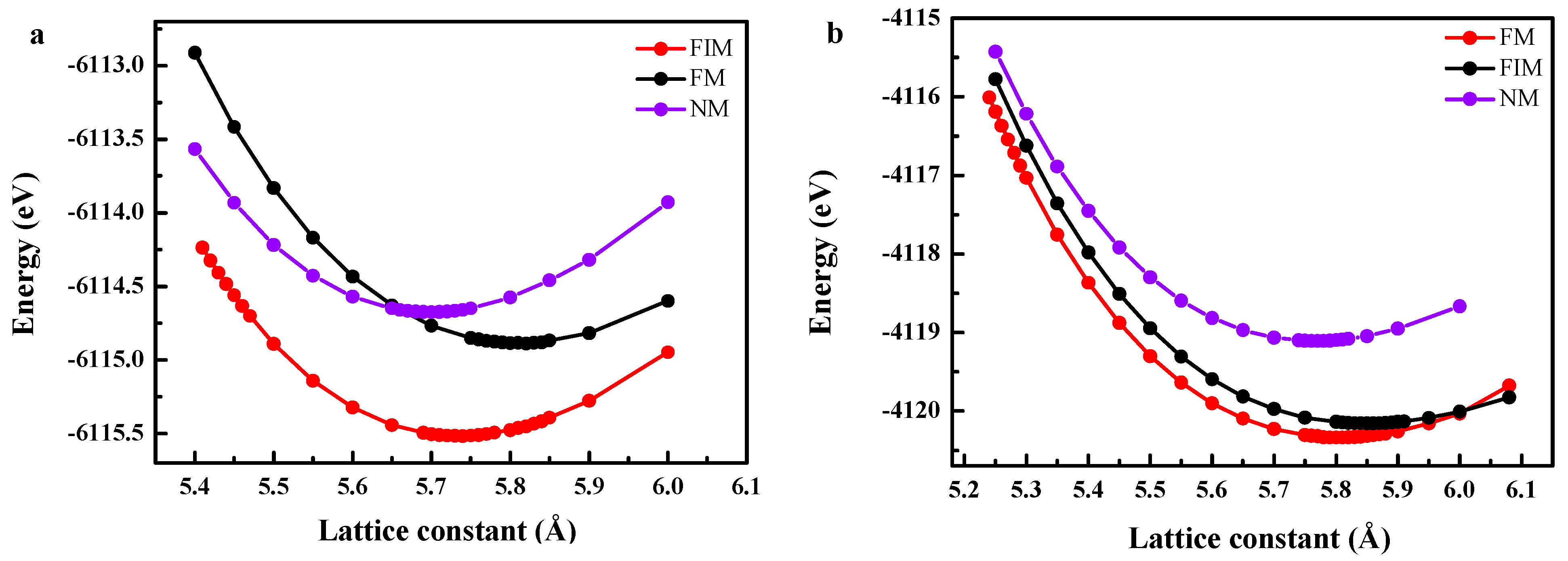
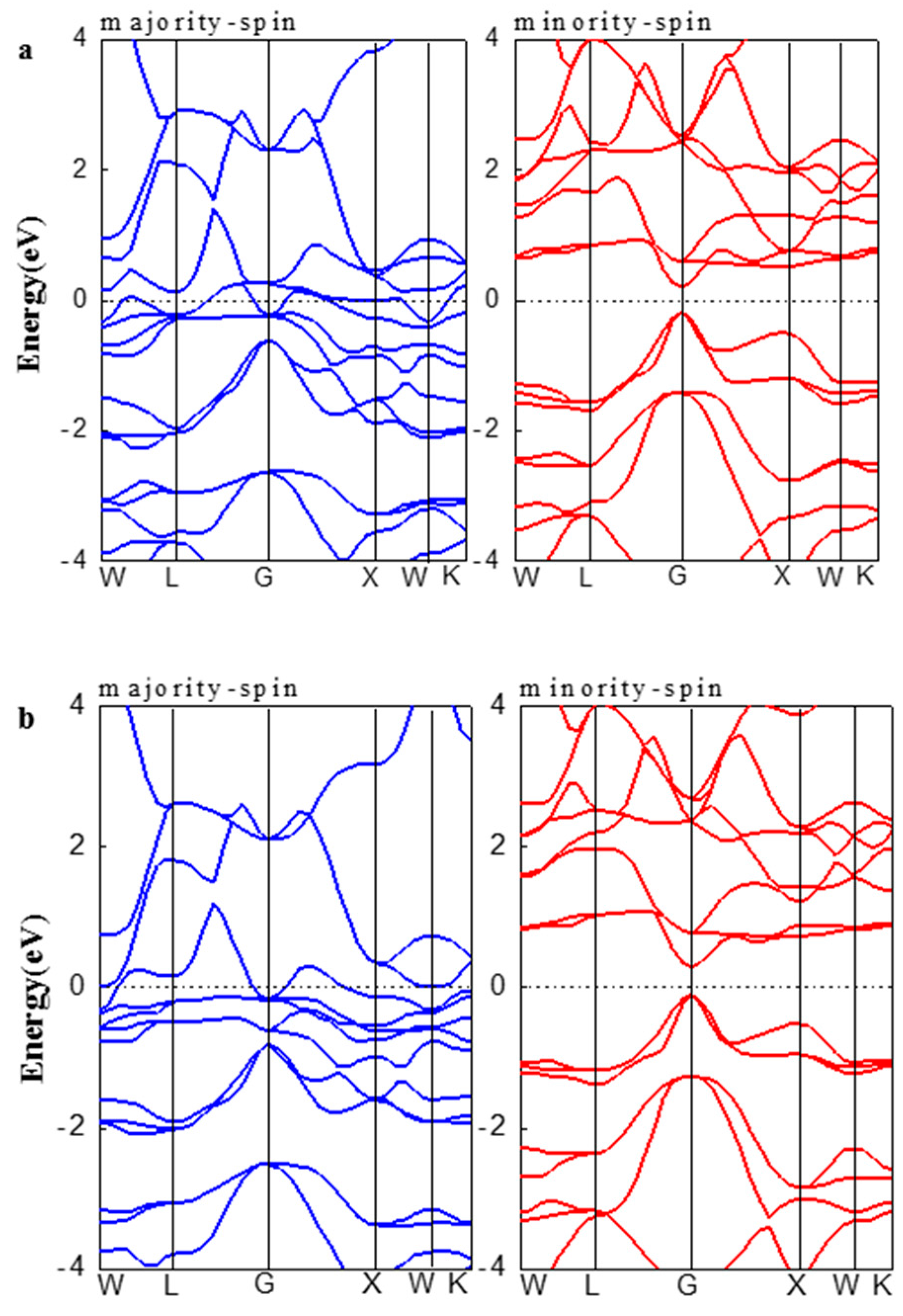

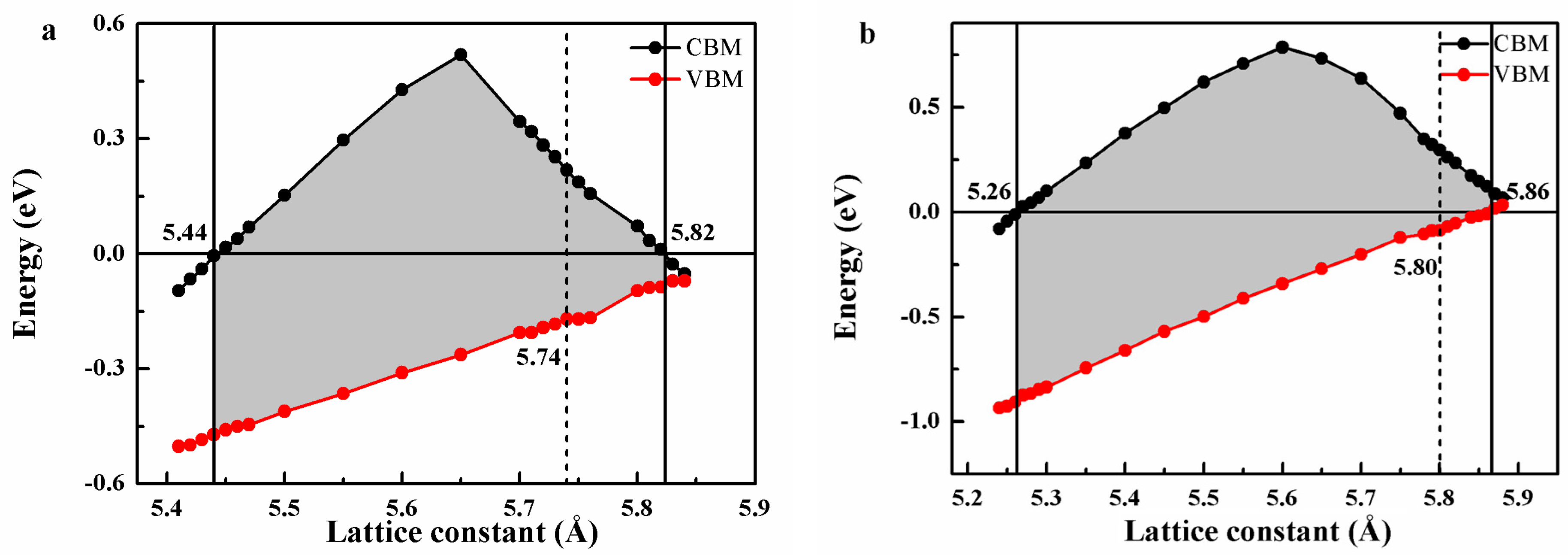
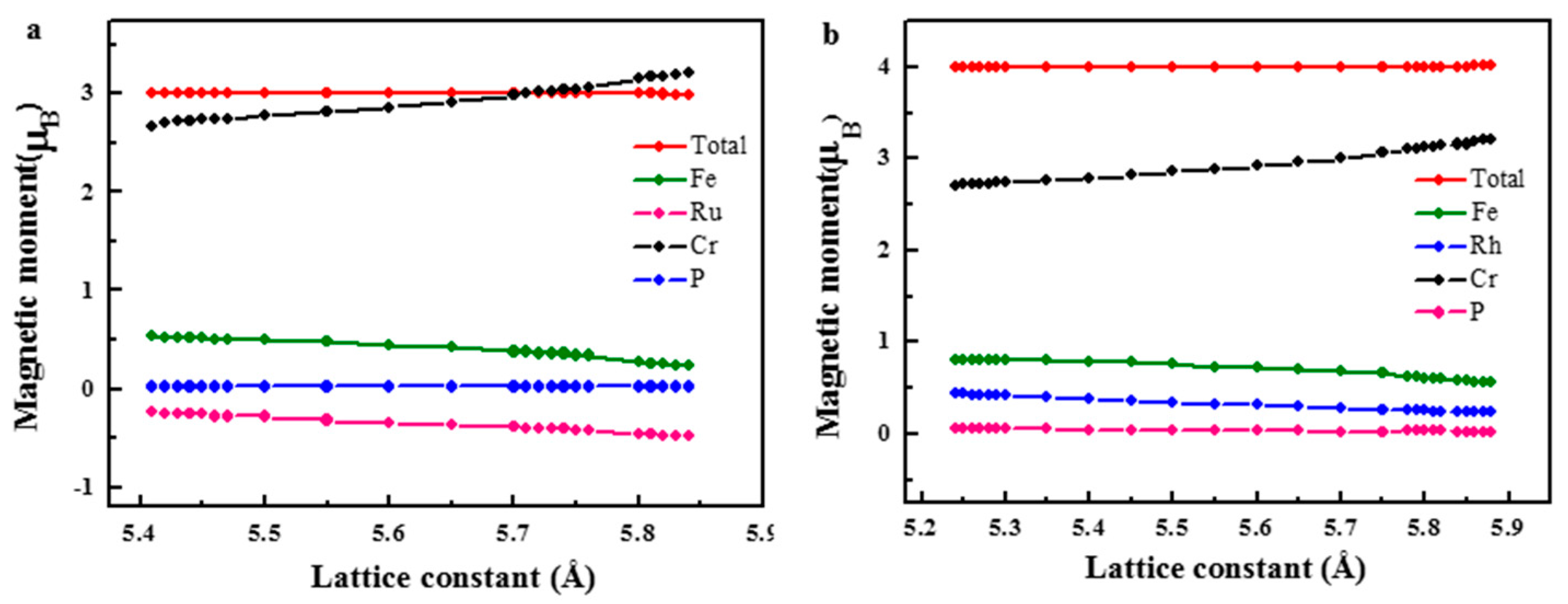
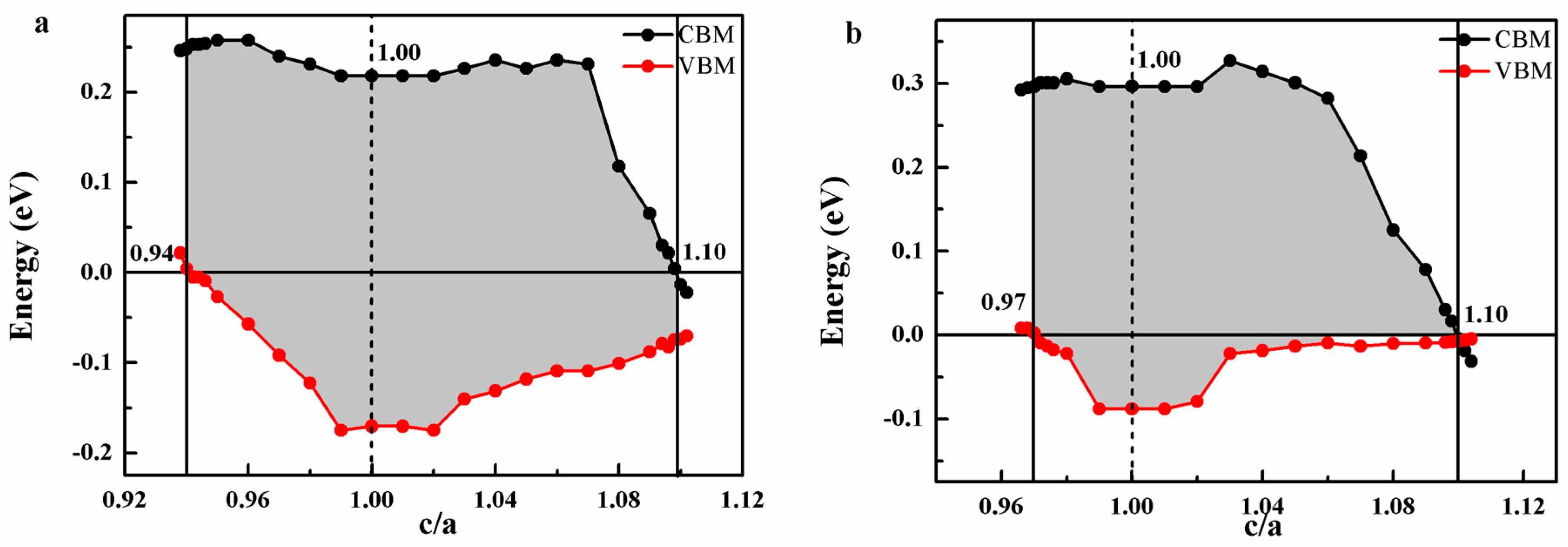
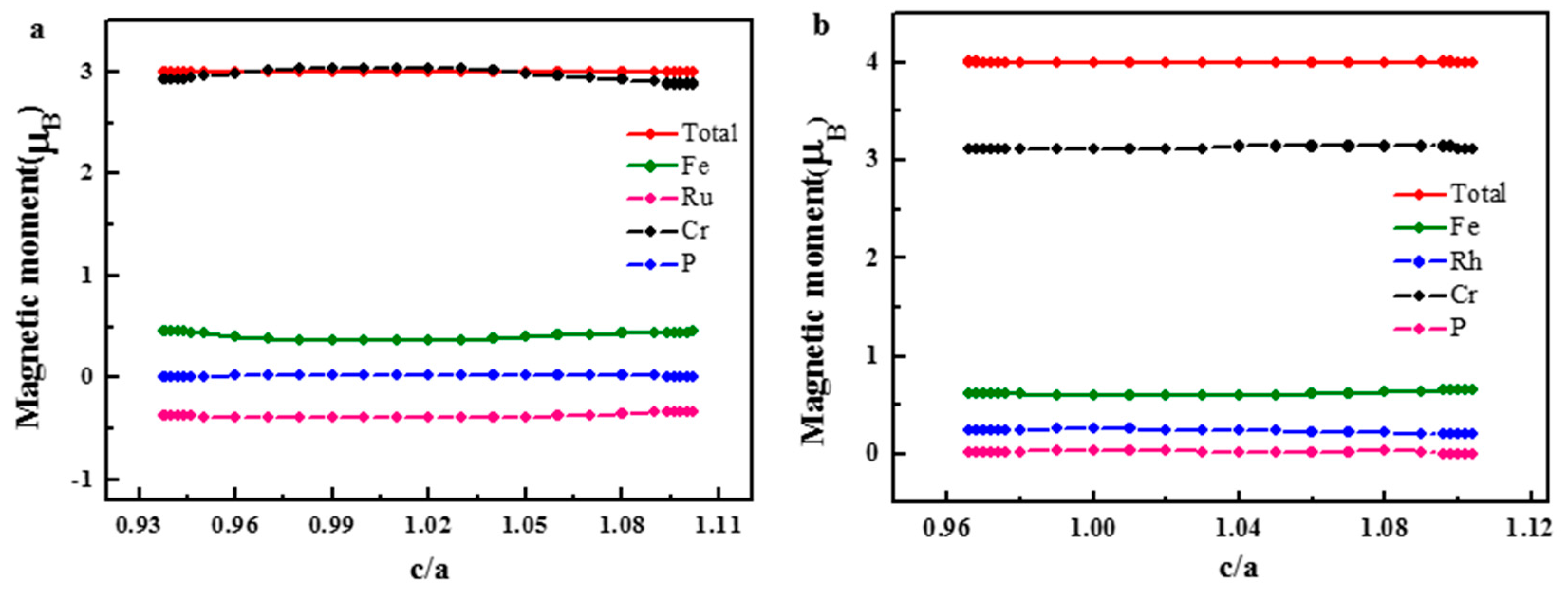
| Structure | Fe | Ru/Rh | Cr | P |
|---|---|---|---|---|
| type 1 | 4a | 4c | 4b | 4d |
| type 2 | 4b | 4c | 4a | 4d |
| type 3 | 4a | 4b | 4c | 4d |
| Compounds | a0 | Mtot | MFe | MRu/MRh | MCr | MP | Efor | Ecoh |
|---|---|---|---|---|---|---|---|---|
| FeRuCrP | 5.74 | 3.00 | 0.36 | −0.40 | 3.04 | 0.02 | −2.82 | −19.95 |
| FeRhCrP | 5.80 | 4.00 | 0.60 | 0.26 | 3.12 | 0.04 | −3.30 | −17.27 |
© 2017 by the authors. Licensee MDPI, Basel, Switzerland. This article is an open access article distributed under the terms and conditions of the Creative Commons Attribution (CC BY) license (http://creativecommons.org/licenses/by/4.0/).
Share and Cite
Ma, J.; Feng, L.; Guo, R.; Liao, Y.; Khenata, R.; Liu, G.; Wang, L. New Half-Metallic Materials: FeRuCrP and FeRhCrP Quaternary Heusler Compounds. Materials 2017, 10, 1367. https://doi.org/10.3390/ma10121367
Ma J, Feng L, Guo R, Liao Y, Khenata R, Liu G, Wang L. New Half-Metallic Materials: FeRuCrP and FeRhCrP Quaternary Heusler Compounds. Materials. 2017; 10(12):1367. https://doi.org/10.3390/ma10121367
Chicago/Turabian StyleMa, Jiannan, Liefeng Feng, Ruikang Guo, Yi Liao, Rabah Khenata, Guodong Liu, and Liying Wang. 2017. "New Half-Metallic Materials: FeRuCrP and FeRhCrP Quaternary Heusler Compounds" Materials 10, no. 12: 1367. https://doi.org/10.3390/ma10121367




